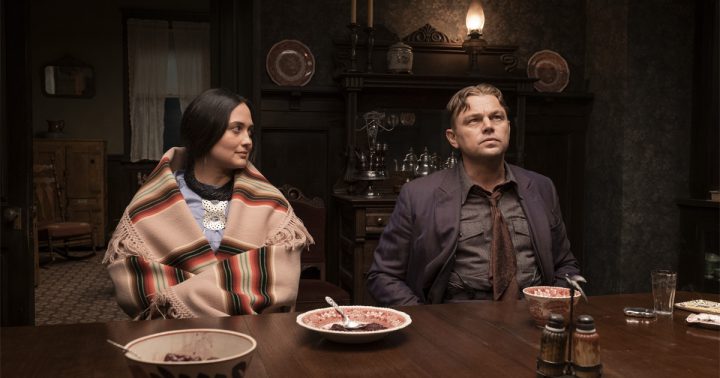
David Grann’s book Killers of the Flower Moon took the world by storm in 2017, with Time listing it as one of the best nonfiction books of the year. It was a riveting and tragic tale of a hidden part of America’s history, where systemic abuse of the legal system and unbridled greed trampled across the lives of some of America’s original people: the Osage Indians. Despite being non-fiction, Grann’s deft story-telling ability crafted history into a murder mystery thriller, with gradual unveiling of facts leading to disheartening revelations and a humbling reminder that we can’t forget our past or we are doomed to repeat it.
It’s no surprise that this story grabbed Martin Scorsese‘s attention. He is a director whose career has been built on telling stories of structural criminality, and what compels individuals to engage in criminal behavior. The road to production was long and winding, with COVID-19 delaying the film for years. But at long last, Scorsese’s take on the material arrives.
Unfortunately, Scorsese’s version largely jettisons one of the greatest aspects of the novel: the mystery aspect. While there are small bits of intrigue at the start, the film doesn’t waste any time showing you the motivations of all involved. This does allow the film to focus more on the nature of the relationship between Leonardo DiCaprio‘s Ernest and Robert De Niro‘s Tom Hale. But without the mystery aspect, the 3 hour+ runtime does drag in certain parts. The film feels less like a gradual unveiling of horrible truths than the book did, and instead spends lots of screen time on the particularities of certain characters interacting.
Fortunately those scenes pop, because the cast is simply fantastic. Robert De Niro looms over the film like a dark shadow and completely sells the nature of his character. The kindly, genial manner he presents is aided by his now advanced age. The hint of menace lurking behind his eyes and tone of voice add plenty to the performance.
DiCaprio, meanwhile, channels the best parts of his various characters from over the years. Ernest is a character who is equal parts naive, charming, and unhinged. These are all qualities DiCaprio has expressed in his varying performances, brought together here in one of his most complex characters. He truly sells Ernest’s ambiguity, even where the script seems to make Ernest more overtly complicit in the criminal acts than the novel. The way DiCaprio and De Niro play off of each other in their scenes makes you wish we’d had more films over the years where they got to work together.
Country music fans will also enjoy seeing Jason Isbell and Sturgill Simpson play small roles in the film. Simpson has quietly put together a modest acting career and is funny and charming in this role. Isbell’s role is slightly stiffer, though his character doesn’t give him much to work with.
A character who does have more to work with but has a somewhat disappointing performance is Jesse Plemons‘ Tom White. A Texas Ranger turned FBI agent who starts investigating the murders, White would seem primed to stand in stark difference to the characters that DiCaprio and De Niro play. But due to the film’s focus, White’s role is vastly reduced compared to the novel, and Plemons does little to make him pop, especially if you compare him to Kyle Chandler‘s great turn as an FBI agent in Scorsese’s The Wolf of Wall Street. While it is impossible to fit everything from the book into a film, even one as long as this, the reduction of this character can’t help but feel a mistake. An entire angle of the book, the birth of the FBI into an entity of national prominence, is jettisoned from the film.
Who isn’t disappointing is Lily Gladstone as Mollie. The wife of DiCaprio’s Ernest, Mollie’s character endures much suffering throughout the film. While this character could easily feel one-note in other hands, Gladstone brings her suffering to life in a multitude of ways. She has joy and snark in scenes where she isn’t grieving or isn’t sick. These scenes make Mollie easy to like, and thus easy to empathize with. Gladstone makes both types of scenes work, and makes the character stand out against the titans she acts alongside — a fitting talent for a film that tries to highlight the native peoples of America.
Native culture is laced throughout the film. The colors and production design all showcase the experiences of the Osage people. Their rituals and conversations are often depicted without subtitles, as Scorsese gives them attention without any distractions from the bottom of the screen. All the necessary meaning is conveyed in the visuals and sound. The 20s period also pops to life with intricate costuming. The score is also excellent, setting a powerful mood throughout various scenes, and working in era-appropriate songs as well as Native American music. Composer Robbie Robertson, another frequent Scorsese collaborator, should be commended for his efforts.
Despite the immense scope of the production, though, Scorese’s story choices can’t help but feel like they cut against the inherently grandiose nature. The film spends too much laxly covering various character interactions. It seems strange to call a 200+ minute Scorsese film lacking in scale, but Killers of the Flower Moon is missing a bigger picture.
That’s not to say it isn’t a good or even great film. This is still Martin Scorsese, and he creates many great scenes. Many are heartbreaking to watch due to the great performances and casual violence on display. Those sudden bursts of merciless and uncaring murder help convey the film’s themes about the lack of care given to Native Americans. Yet despite all the hype, Killers of the Flower Moon is probably the least among Scorsese’s work of the past ten years.
Thankfully, it’s still one of the better films of the year and even of the last few years. For all its flaws, Killers of the Flower Moon is gripping and harrowing, and is must-see cinema for the light it shines on a brutal part of American history. Getting to see so many of Scorsese’s frequent partners come together is a treat for all cinema fans.
